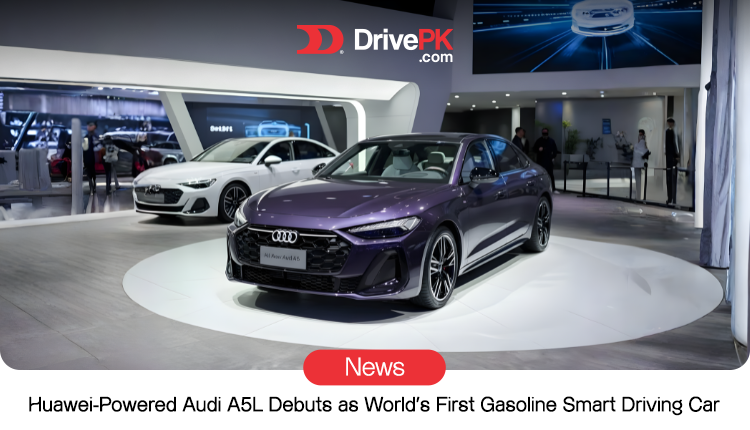China Just Dropped the First Petrol Car That Drives Itself Like a Huawei EV
Audi shocked the market at the Guangzhou Auto Show 2025 by launching the A5L Qiankun Edition, the world’s first petrol car fitted with Huawei’s full autonomous driving system, including dual LiDAR and 33 sensors for advanced NOA driving.

Table of Contents
- 33 Sensors and Two LiDARs on a Petrol Audi
- Looks Different From Regular A5L
- Same Engine, New Brain
- Why This Actually Matters
- Only in China for Now
- Delivery starts early 2026.
At the 2025 Guangzhou Auto Show, FAW-Audi pulled the covers off something nobody saw coming: an Audi A5L that runs on petrol but thinks like the smartest electric cars from China. They call it the Audi A5L Qiankun Intelligent Driving Edition. Price? 286,800 yuan – about PKR 11.2 million if you convert it straight.
And yes, it’s the first pure petrol car in the world to get Huawei’s full Qiankun smart-driving system.
33 Sensors and Two LiDARs on a Petrol Audi
Most people only see Huawei’s tech in electric cars like the Aito M9 or Avatr 12. This time they stuffed the same brain into a normal 2.0-litre turbo Audi.
What’s inside:
- 2 LiDAR units (one on each side of the bumper)
- 12 cameras
- 5 millimeter-wave radars
- 12 ultrasonic sensors
- Plus the usual high-precision maps and positioning hardware
That setup lets the car do city and highway NOA (Navigate on Autopilot) without the driver touching the wheel or pedals on approved roads. It can change lanes by itself, overtake slow trucks, handle roundabouts, and even park without anyone inside.
Looks Different From Regular A5L
The Qiankun edition is easy to spot:
- Illuminated Audi rings front and back
- OLED tail lights that run edge-to-edge
- Hidden door handles
- Longer wheelbase (2969 mm), 11 cm more than the global A5, so back-seat passengers get proper legroom
Inside, you get three big screens across the dash, a separate passenger display, and Bang & Olufsen speakers that actually sound good.
Same Engine, New Brain
Under the hood, it’s the familiar 2.0T with 201 hp and a 7-speed dual-clutch box. 0 to 100 km/h takes 8.2 seconds. Nothing crazy, but the fuel tank is normal petrol, so you can fill up anywhere, no waiting for chargers.
Why This Actually Matters
Until yesterday, if you wanted Huawei’s best self-driving tech, you had to buy an electric or extended-range car. Now you can have it in a normal petrol sedan that your uncle in Faisalabad can refuel in two minutes.
Audi gets to sell a “smart” car without building a new EV platform. Huawei proves its system works on any powertrain. And customers who don’t trust batteries yet still get Level 2+ autonomy today, maybe Level 3 tomorrow when rules allow.
Only in China for Now
No word yet on exports. The global A5/A5L sold elsewhere doesn’t have this hardware, and adding two LiDARs would probably scare European regulators for a few years.
But if you live in China and want a petrol car that can drive you home from Guangzhou to Shenzhen while you watch a movie, you can order one right now.
Delivery starts early 2026.
For the rest of us, it’s proof that the gap between Chinese “new forces” tech and traditional brands just disappeared overnight.
For more updates, visit DrivePK.com
Tags
Share this article
About the Author
Najeeb Khan
Automotive enthusiast and writer
Comments (0)
Login Required
You need to be logged in to comment on this article.
No comments yet. Be the first to share your thoughts!
Related Articles

China Took the Top 20 Fastest Electric Cars List, And Might Nerf Them Next Week
Chinese EVs swept the global top 20 fastest-accelerating cars, with the Hyptec SSR, Xiaomi SU7 Ultra, and Zeekr 001 FR beating Tesla, Porsche, and Lamborghini, just as China considers new rules that could limit extreme acceleration from cold starts.

Pakistan Railways Just Upgraded the Lasani Express, And It Actually Looks Good
Pakistan Railways has upgraded the Lasani Express with new locally-built coaches offering better seating, cleaner interiors, and improved safety for daily passengers on the Lahore, Narowal, and Sialkot route.